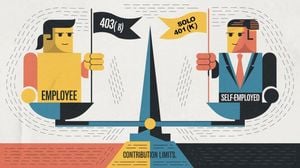Delhi is shrouded once again by its infamous smog as the city grapples with alarming levels of air pollution. To combat this crisis, the Delhi government has implemented strict measures including the enforcement of the Graded Response Action Plan (GRAP-III). This plan entails banning certain vehicular emissions, namely BS-III petrol and BS-IV diesel vehicles, from plying on the roads of the national capital starting from November 16, 2024. The penalties for those daring to defy these regulations have ramped up significantly, with violations resulting in fines of up to ₹20,000 under the Motor Vehicle Act.
The visibility on the roads has plummeted as Delhi recorded a hazardous Air Quality Index (AQI), which recently dipped to 396—a number still categorized as 'very poor.' Comparatively, the region had experienced AQI levels of 424, previously marking it as 'severe.' The Indian Institute of Tropical Meteorology (IITM) forecasts indicate no immediate relief, expecting air quality to remain very poor for at least six days following the announcement.
This latest implementation of GRAP-III follows the orders issued by the Commission for Air Quality Management. Active measures have also been put forth, mandatorily banning construction work, demolition activities, and transportation of waste materials. This stringent regulation aims to tackle the buildup of airborne particulate matter strongly affecting the health of Delhi's residents.
With increasing public health concerns, hospitals are reporting spikes in respiratory-related admissions. The situation has reached such extremes, activists and political figures alike are characterizing Delhi as having transformed the cityscape to resemble “a gas chamber.”
Delhi's pollution issues are not merely related to traffic or construction activities; recent investigations have unveiled another layer of complexity—fraudulent pollution control certificates. India Today’s Special Investigation Team uncovered rampant issuance of fake pollution under control (PUC) certificates throughout key areas of Delhi and its neighboring regions, including Noida and Ghaziabad. Shockingly, these documents were often obtained without any actual vehicle inspections, allowing polluting vehicles to continue operations unchecked.
This troubling practice was highlighted when investigators visited various PUC centers, discovering employees issuing certificates simply for cash, often bypassing even the most basic checks on vehicle conditions. For example, at one location, staff would issue certificates without inspecting vehicles, and even provided assistance on obtaining documents to escape scrutiny. One noteworthy transaction observed was the issuance of fake PUC certificates for as low as ₹150 to ₹200, providing vehicle owners with the vehicle approval they desired without any legitimate guarantees of compliance.
The magnitude of pollution levels invite each resident to question the efficacy of current measures when stringent regulations are undermined by such deceitful practices. While the government clamps down on vehicles and construction, it remains imperative to confront and dismantle these corrupt elements contributing to the overall crisis.
Public sentiment reflects growing frustration, with calls for accountability directed not only at polluters but also at the systems enabling their activities. The current skyline of Delhi tells more than just the tale of its historical architecture; it tells of mismanagement, delayed action, and the adverse reality of living under severe pollution load.
To address these issues, it is not enough to recourse to stringent regulations. Comprehensive reforms targeting loopholes enabling the issuance of fake PUCs must be introduced alongside pro-active measures aimed at ensuring compliance with emission standards. This not only requires improved bureaucratic oversight but demands community awareness and involvement.
The government’s action plan, including the escalation of road cleaning, water spraying, and increased frequency of public transport services, indicates their intent to restore some semblance of clean air to the capital. Yet, as they enact these emergency measures, the growing network of dishonest practices reflects the broader battle against pollution and environmental negligence.
While large-scale change takes time, each effort must be directed intentionally, ensuring measures are both enforced and enacted with integrity. Only then can the shadow of Delhi’s pollution woes begin to lift, paving the way for healthier living conditions for its citizens.
The bright side, if there is one, remains the commitment of environmentalists and engaged citizens who continue to speak out against such socio-environmental dilemmas. The path toward cleaner air is steep, yet with dedicated perseverance and rigorous enforcement of genuine, transparent policies, hope remains on the horizon.



